Humanoid Robot Market Research, 2031
The Global Humanoid Robot Market was valued at $307.6 million in 2021 and is projected to reach $609.5 million by 2031, growing at a CAGR of 7.7% from 2022 to 2031.
Significant indicators that the field of robotics is undergoing major transformation and development include the rise in commercial investment, the appearance of international players, decreased hardware costs, and the popularity of the existing robots.
Humanoid robotics can be helpful in research on embodiment and consciousness as well as, more broadly, the neuro and cognitive sciences, aside from pure robotics. They are also pictured working in the entertainment industry as receptionists and engaging in various social interactions, such as helping elderly people. Companies like as SoftBank Robotics in Japan and PAL Robotics in Spain have invested heavily in the creation of humanoid robots, and they have incorporated this technology into their business strategy in a variety of ways. One of these companies’ primary objectives is to create robots that may be used in the service industry, specifically in healthcare, hospitality, and retail.
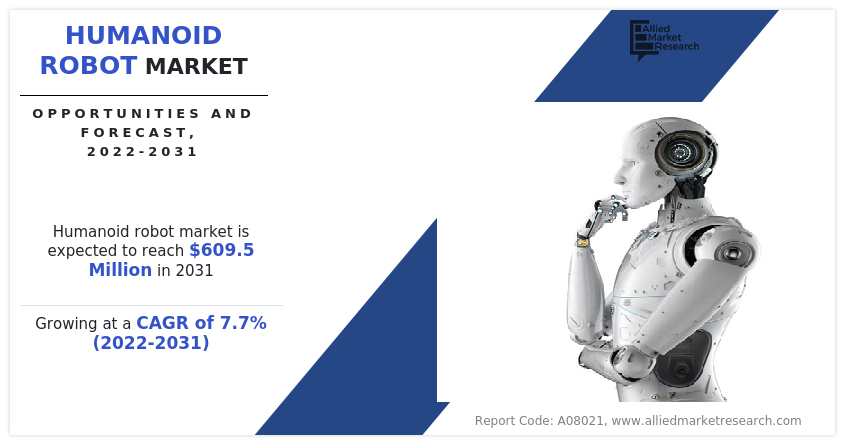
The high price of the humanoid robot industry has been a major obstacle to their adoption, and finding the right financing and leasing options is just as important as choosing the right robot. When operating and deploying these robots, brick-and-mortar businesses need to carefully balance concerns about human labor. By giving businesses different payment options that can make the initial investment more manageable, financing and leasing options can assist in removing this barrier. Some robot distributors and manufacturers provide financing and leasing plans for their goods, enabling companies to pay for the robots over time rather than all at once.
The global market for humanoid robots is expected to experience significant growth potential due to the quick technological improvements in the creation of more effective and affordable robot models. Additionally, it is anticipated that the market will grow in the upcoming years due to the increasing adoption of humanoid robots for military & defense applications to provide battlefield intelligence or knowledge of enemy movements. In addition, the expanding trend of industry automation is anticipated to increase the demand for humanoid robots shortly.
Key Takeaways
- The global humanoid robot market study covers 20 countries. The research includes a segment analysis of each country in terms of value for the projected period.
- More than 1,500 product literature, industry releases, annual reports, and other such documents of major market industry participants along with authentic industry journals, trade associations' releases, and government websites have been reviewed for generating high-value industry insights.
- The study integrated high-quality data, professional opinions and analysis, and critical independent perspectives. The research approach is intended to provide a balanced view of the global humanoid robot market and to assist stakeholders in making educated decisions to achieve their most ambitious growth objectives.
Segment Overview
The global humanoid robot market is segmented based on component, application, motion type, and region. By component, the market is sub-segmented into hardware and software. By application, the market is classified into research & space exploration, education & entertainment, personal assistance & caregiving, hospitality, search & rescue, and others. By motion type, the market is classified into biped and wheel drive. By region, the market is analyzed across North America, Europe, Asia-Pacific, and LAMEA.
By Component
The hardware sub-segment dominated the market in 2021. Hardware components in particular enhance humanoid robots' ability to interact with humans. Advances in materials science, robotics engineering, and control systems design have all contributed to the development of more sophisticated and capable robots that can perform a wider range of tasks with greater efficiency and precision. All these factors are driving the hardware sub-segment during the forecast period.
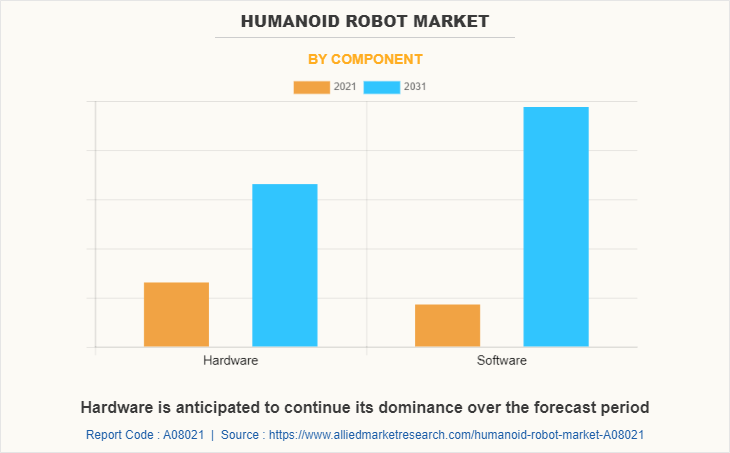
By Application
The personal assistance & caregiving sub-segment dominated the global humanoid robot market share in 2021. Humanoid robots were viewed as a valuable resource during the coronavirus outbreak because the virus does not affect them. They could easily monitor patients and offer vital services without assistance from humans. These machines are therefore being used more frequently, which raises their worth. The humanoid robots will be able to perform other fundamental medical tasks without endangering the health of human healthcare workers. These are predicted to be the major factors affecting the humanoid robot market size during the forecast period too.
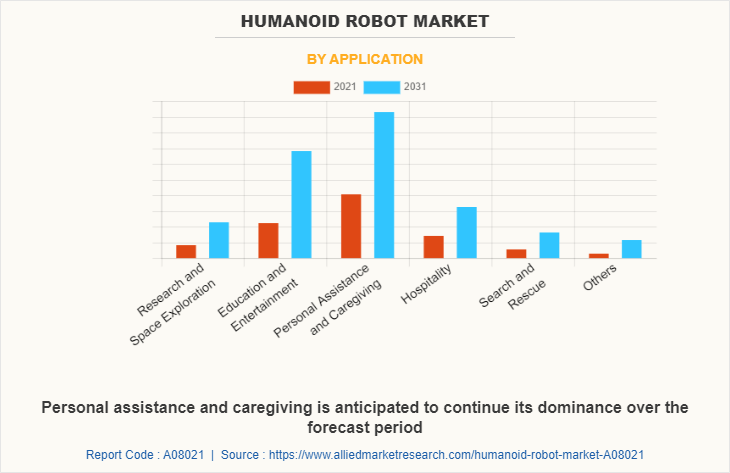
By Motion Type
The wheel drive sub-segment dominated the global humanoid robot market share in 2021. The wheel drive robots are simple to build and can be programmed to navigate their environment. Because of its numerous advantages, demand for wheel-type robots in army & defense applications is expected to grow. Robots are used as entertainment in scientific fairs, theme parks, and amusement parks. These factors are expected to drive the humanoid robot market forecast period growth in the upcoming year.
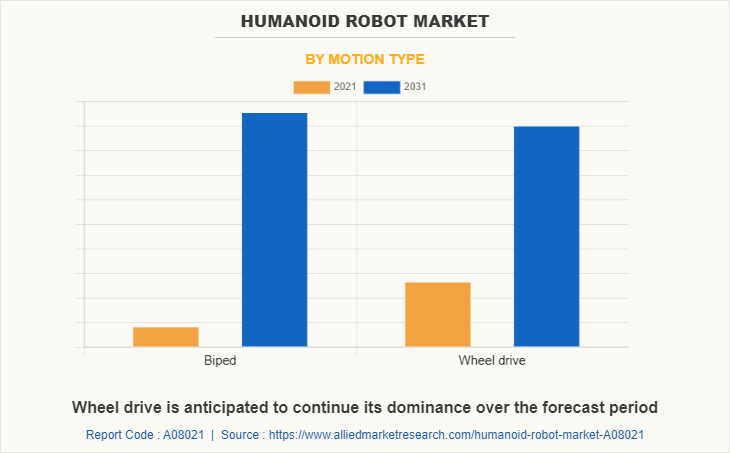
By Region
Asia-Pacific dominated the global humanoid robot market in 2021 and is projected to remain the fastest-growing sub-segment during the forecast period. The presence of prominent competitors, as well as the adoption of automated systems by the majority of industry verticals, is expected to result in considerable development in the Asia-Pacific market. Furthermore, labor shortages combined with high labor costs are increasing the demand for humanoid robots to perform tasks in industries such as construction, manufacturing, and retail, which is expected to drive market growth in Asia-Pacific.
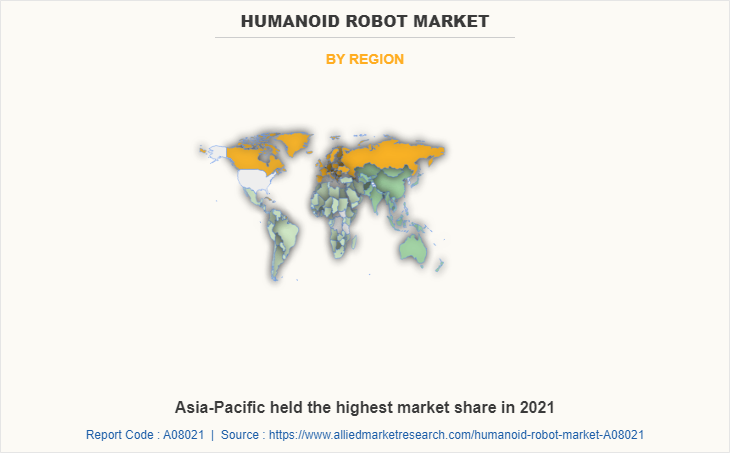
Key Market Dynamics
Rapid improvements in artificial intelligence (AI) and machine learning (ML) are enhancing the capabilities of humanoid robots, allowing them to perform complex tasks and interact more naturally with humans. Notably, innovations like NVIDIA's Project GR00T aim to facilitate advanced learning and adaptability in humanoid robots, making them more efficient in various applications. The increasing global elderly population is creating a substantial demand for humanoid robots in healthcare and personal assistance roles. These robots can offer mobility support, medication reminders, and companionship, addressing the needs of the elderly and relieving caregiver pressure.
Regional/Country Market Outlook
- North America: In North America, particularly the United States, the humanoid robot market is expanding rapidly due to significant investments in research and development. Companies like Agility Robotics are leading the charge with innovative products designed for both industrial and domestic applications. The region's advanced technological infrastructure and high demand for automation in healthcare and service sectors are key drivers of this growth.
- Asia-Pacific: The Asia-Pacific region, especially countries like Japan and China, is expected to dominate the humanoid robot market in the coming years. Japan's longstanding interest in robotics and the increasing adoption of robots in manufacturing and elder care are significant contributors. China is rapidly emerging as a major player, focusing on robotics in education and personal assistance, supported by government initiatives and funding.
- Europe: Europe is also witnessing substantial growth in the humanoid robot market, with countries like Germany, France, and the UK at the forefront. The demand for humanoid robots in healthcare and elder care is particularly strong, driven by an aging population and a strong emphasis on technological solutions in the healthcare sector. Collaborative initiatives between companies and universities in robotics research further bolster this market.
- Latin America & Middle East: The Middle East and Africa are gradually adopting humanoid robots, primarily in sectors like hospitality and tourism. However, this region lags behind others in terms of overall market size and technological integration. The growing interest in automation and smart technologies is expected to drive future growth.
Competitive Analysis
The key players profiled in this report include HYULIM Robot Co., Ltd, HANSON ROBOTICS LTD, Engineered Arts Limited, Honda, KAWADA Robotics Corporation, SoftBank Robotics, Sanbot Co, ROBOTIS, Willow Garage, and Toshiba Corporation.
Report Coverage & Deliverables
This report delivers in-depth insights into the humanoid robot market by component, application, motion type, and region, and key strategies employed by major players. It offers detailed humanoid robot market forecasts and emerging trends.
Component Insights
The software component involves the programming and algorithms that enable humanoid robots to perform tasks, learn from their environments, and interact with users. Advancements in artificial intelligence (AI) and machine learning are driving the development of more sophisticated software, allowing robots to adapt and improve their performance over time. This segment is expected to see significant growth as developers focus on enhancing user experience and automation capabilities.
Application Insights
Humanoid robots are increasingly being used in research settings and space missions due to their ability to perform complex tasks in environments that may be hazardous for humans. Robots like NASA’s Valkyrie are designed to assist in space exploration and research projects, offering valuable support in extreme conditions.
Motion Type Insights
Biped robots, designed to walk on two legs, offer a more human-like interaction experience. This motion type is critical for applications where human-like navigation and interaction are essential, such as in personal assistance and hospitality. Wheel-driven robots are typically more stable and can travel faster over flat surfaces. This design is advantageous for applications requiring quick mobility, such as in search and rescue or logistics
Regional Insights
The Asia-Pacific region is projected to dominate the humanoid robot market in the coming years, with Japan and China leading the way. Japan has a long-standing cultural affinity for robotics, making it a key player in the development of humanoid robots for personal assistance and caregiving. Meanwhile, China is rapidly advancing its robotics sector, with government support and a focus on integrating humanoid robots in education, healthcare, and industrial applications. The increasing adoption of robots in logistics and service sectors is expected to further fuel growth in this region.
Key Strategies and Developments
- In 2024 - Unitree Robotics launched the G1 humanoid robot. This model is designed as a more compact and cost-effective alternative to its predecessor, the H1, making it suitable for research and development rather than direct human labor replacement. The G1 features customizable options, including three-fingered hands and advanced sensors, aimed primarily at university labs for developing AI algorithms.
- In 2024 - GXO Logistics announced a multi-year agreement with Agility Robotics to deploy their humanoid robot, Digit, in their logistics operations. This follows a successful pilot program from late 2023 and marks the first commercial deployment of humanoid robots in a logistics environment.
Key Benefits for Stakeholders
- This report provides a quantitative analysis of the humanoid robot market segments, current trends, estimations, and dynamics of the humanoid robot market analysis from 2021 to 2031 to identify the prevailing humanoid robot market opportunity.
- The market research is offered along with information related to key drivers, restraints, and opportunities.
- Porter's five forces analysis highlights the potency of buyers and suppliers to enable stakeholders to make profit-oriented business decisions and strengthen their supplier-buyer network.
- An in-depth analysis of the humanoid robot market segmentation assists in determining the prevailing market opportunities.
- Major countries in each region are mapped according to their revenue contribution to the global market.
- Market player positioning facilitates benchmarking and provides a clear understanding of the present position of the humanoid robot market players.
- The report includes an analysis of the regional as well as global humanoid robot market trends, key players, market segments, application areas, and market growth strategies.
Humanoid Robot Market Report Highlights
| Aspects | Details |
| Market Size By 2031 | USD 609.5 million |
| Growth Rate | CAGR of 7.7% |
| Forecast period | 2021 - 2031 |
| Report Pages | 280 |
| By Component |
|
| By Application |
|
| By Motion Type |
|
| By Region |
|
| Key Market Players | PAL ROBOTICS, HYULIM ROBOT, Honda Motor Co. Ltd., Hajime Research Institute, Ltd., TOYOTA MOTOR CORPORATION, Trossen Robotics, HANSON ROBOTICS LTD, KAWADA Robotics Corp., Toshiba Corporation, SoftBank Robotics |
Growing developments in robot manufacturing, as well as increased usage of humanoid robots in the retail sector to improve user experience and engagement, have been identified as important driving factors for the humanoid robot market. Continuous improvements in technology to increase the cost effectiveness and efficiency of robots are likely to generate significant opportunities for the growth of the humanoid robot market.
The major growth strategies adopted by humanoid robot market players are investment and agreement.
Asia-Pacific will provide more business opportunities for the global humanoid robot market in future.
HYULIM Robot Co., Ltd, HANSON ROBOTICS LTD, Engineered Arts Limited, Honda, KAWADA Robotics Corporation, SoftBank Robotics, Sanbot Co, ROBOTIS, Willow Garage, and Toshiba Corporation are the major players in the humanoid robot market.
Personal assistance & caregiving sub-segment of the application acquired the maximum share of the global humanoid robot market in 2021.
The report provides an extensive qualitative and quantitative analysis of the current trends and future estimations of the global humanoid robot market from 2021 to 2031 to determine the prevailing opportunities.
Autonomous humanoid robots are becoming more prevalent, with robots that can navigate environments and perform tasks without human intervention. This includes robots that can perform tasks such as cleaning and maintenance in public spaces and commercial buildings.
Loading Table Of Content...
Loading Research Methodology...



